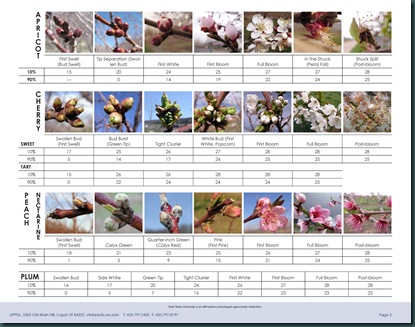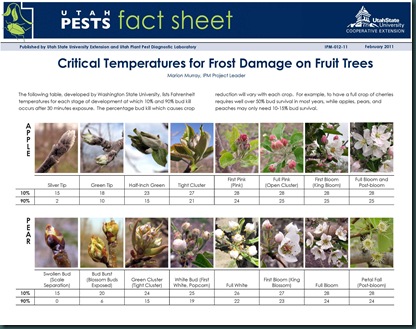Early spring is the time of the year when apple trees are beginning to wake up from their winter sleep, and is also the time for colder night temperatures that we are sure to see. It's always a good idea to revisit the critical temperatures that can cause frost or freeze damage to fruit trees, specifically apple trees. We are currently at silver tip to green tip here in northern Illinois with a forecast of night temperatures in the low 20's later in the week. Fortunately, our trees haven't progressed to far this spring, but we could see green tip next week. This spring has marked another unprecedented weather pattern that raised our temperatures in late March and and is dropping our temperatures the first few days of April. The early warm temperatures accelerated bud swell, and the lower temperatures that are anticipated present the threat of frost or freeze damage to new green tip leaf tissue. It seems that each spring since about 2012, we have been on the verge of critical temperatures for frost or freeze damage with our fruit trees.
As the trees develop in the spring and buds start to swell, they lose the ability to withstand the cold winter temperatures that they could withstand in dormancy during the cold winter months. The young, actively growing tissue can then be damaged or even killed. Swollen fruit buds can better withstand temperatures in the teens without any damage. As the buds open, temperatures in the low 20s can cause harm, but sometimes leave other buds undamaged. As growth moves from green tip to 1/4” green to 1/2” green to tight cluster to pink in apple trees, temperatures in the upper 20s can cause considerable harm to an early blooming tree. Near bloom, the range between slight and severe damage can be very small. Freezing temperatures of 28 degrees F. will result in about a 10 percent loss and 24 F will result in a 90 percent loss, as indicated by the charts down below.
In a radiation freeze with clear, calm conditions, fruit at higher elevations or in the tops of trees will be less damaged than those at lower elevations, since colder air is more dense than warmer air and sinks to ground level, pushing the warmer air up. The percent of flowers killed in a frost may or may not relate directly to lost yield later in the season. With large-fruited fruits such as apples, peaches, plums and pears, the loss of 50 percent of the flower may not be devastating since we may only want a small percentage of the flowers to become fruit, meaning that fruit thinning may be totally unnecessary. So the stage of bud and bloom development determines how susceptible any given fruit crop is when freezes occur. For more information on what those critical temperatures are that can cause freeze damage to trees during development, I have added two charts on the Critical Temperatures For Frost Damage on Fruit Trees from Utah State University below that you can download by clicking on either chart below.
 |
| The dark brown center of this apple flower indicates it was killed by a freeze. (Photo credit: Mark Longstroth, MSU Extension) |
 |
| (Click on the photos to download the chart in PDF format.) |
Given the weather patterns we have experienced so far this spring a spring frost could still be possible. Once the fruit has set, then the critical temperatures that can damage the fruit become lower. We will need to constantly assess the stage of development our trees are at over the next weeks and their susceptibility to possible freeze injury.
If we continue in a spell of colder weather, apple trees will continue to develop more slowly, but once they begin showing tight cluster, pink and bloom, the critical temperature rises from the low 20’s to the high 20s, to levels just below freezing at bloom time, which is the most critical time to get frost damage.
If we continue in a spell of colder weather, apple trees will continue to develop more slowly, but once they begin showing tight cluster, pink and bloom, the critical temperature rises from the low 20’s to the high 20s, to levels just below freezing at bloom time, which is the most critical time to get frost damage.
______________________________________________
Reference in this blog to any specific commercial product, process, or service, or the use of any trade, firm, or corporation name is for general informational purposes only and does not constitute an endorsement, recommendation, or certification of any kind by Royal Oak Farm, Inc. People using such products assume responsibility for their use in accordance with current label directions of the manufacturer.

